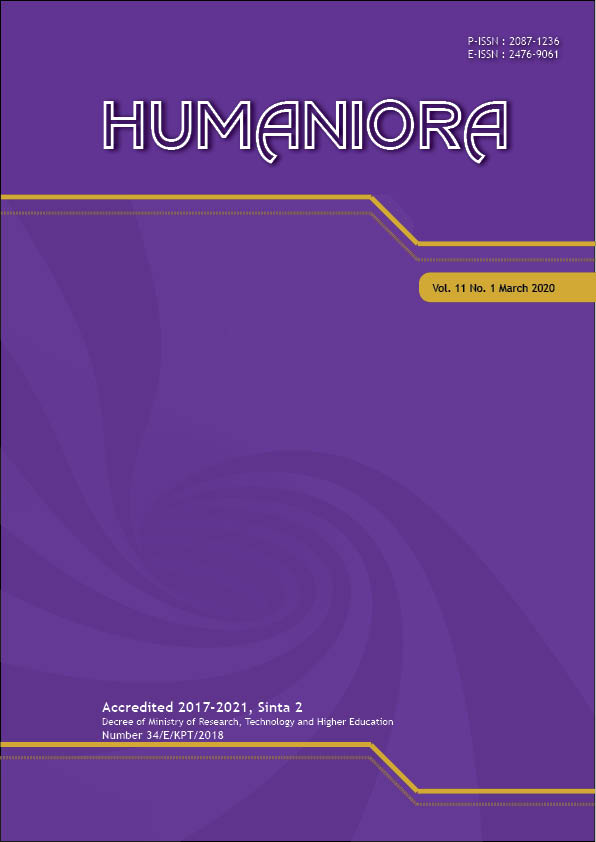“Adverbial†Anaphora Resistance in Students’ Descriptive Texts
DOI:
https://doi.org/10.21512/humaniora.v11i1.6292Keywords:
adverbial anaphora, anaphora resistance, descriptive textsAbstract
The research aimed to analyze adverbial anaphora resistance in students’ descriptive texts at the Department of Indonesian Language Education and Literature, Faculty of Languages and Literature, Universitas Negeri Makassar. The problem “How is adverbial anaphora (resistance) was presented in the descriptive texts written by the students? A descriptive qualitative content analysis was employed in the research. Data collection was performed through documentation of the five-semester students’ descriptive texts. The results show that adverbial anaphora resistance in the students’ descriptive texts consists of: (1) anaphora within adverbs of place (ini “this†and di sana “there†that occupy a different position); (2) anaphora within adverbs of time (tahun “yearâ€, pagi hari “in the morningâ€, and malam hari “at nightâ€); (2) anaphora within adverbs of purpose (bagi “for†and untuk “toâ€); (4) anaphora within adverbs of comparison (seperti “likeâ€); (5) anaphora within adverbs of cause (sebab “cause†and karena “becauseâ€). Adverbial anaphora is highly associated with the placement of words, the relationship between words and phrases, or interrelationship among sentences. The limited number of adverbial anaphora produced by the students originates from the students’ lack of competence in writing a text.
Â
References
Ashima, A., & Rajni Mohana, B. (2016). Improving anaphora resolution by resolving gender and number agreement in Hindi language using rule based approach. Indian Journal of Science and Technology, 9(32), 173-234. https://doi.org/10.17485/ijst/2016/v9i32/100194
Azis, A., & Juanda, J. (2017). Kohesi gramatikal: Kajian keutuhan wacana tugas mahasiswa Pendidikan Bahasa dan Sastra Indonesia, Fakultas Bahasa dan Sastra, Universitas Negeri Makassar. Bahasa dan Seni: Jurnal Bahasa, Sastra, Seni dan Pengajarannya, 45(2), 170-180. https://doi.org/10.17977/um015v45i22017p170
Dekydtspotter, L., Wang, Y., Kim, B., Kim, H., Kim, H., & Lee, J. K. (2012). Anaphora under reconstruction during processing in English as a Second Language. Studies and Second Language Acquisition, 34, 561-590. https://doi.org/10.1017/S0272263112000344
Flores, E. R. (2015). Topical structure analysis as an assessment tool in student academic writing. 3L: The Southeast Asian Journal of English Language Studies, 21(1), 103-115.
Grove, J., & Hanink, E. (2016). Article selection and anaphora in the German relative clause. Semantics and Linguistic Theory, 26, 417-432. https://doi.org/10.3765/salt.v26i0.3806
Hasan, A. (2007). Tata bahasa baku Bahasa Indonesia. In Departemen Pendidikan dan Kebudayaan Republik Indonesia.
Id, A. W., Nuhbalaoglu, D., Mani, N., & Herrmann, A. (2018). Pointing to the right side ? An ERP study on anaphora resolution in German Sign Language. PLoS ONE, 13(9), 1-19. https://doi.org/10.1371/journal.pone.0204223
Jay, E., & Quinto, M. (2015). Physical and topical structures of manpower discourse: A contrastive rhetoric analysis in Southeast Asia. GEMA Online® Journal of Language Studies, 15(February), 91-110.
Juanda, J., & Azis, A. (2018). Wacana percakapan mappitu etnis Bugis Wajo Sulawesi Selatan, Indonesia pendekatan etnografi komunikasi. JP-BSI (Jurnal Pendidikan Bahasa dan Sastra Indonesia), 3(2), 71-76. https://doi.org/10.26737/jp-bsi.v3i2.725
Kraš, T. (2016). Cross-linguistic influence at the discourse–syntax interface: Insights from anaphora resolution in child second language learners of Italian. International Journal of Bilingualism, 20(4), 369-385. https://doi.org/10.1177/1367006915609239
Leonetti, M. (2018). Temporal anaphora with Spanish Imperfecto. Journal of Psycholinguistic Research, 47(2), 391-409. https://doi.org/10.1007/s10936-017-9539-2
Mahato, S., Thomas, A., & Sahu, N. (2017). A survey on anaphora resolution toolkits. In International Journal for Research in Applied Science & Engineering Technology (IJRASET), 5(12), 796-801.
Marasovic, A., Born, L., Opitz, J., & Frank, A. (2018). A mention-ranking model for abstract anaphora resolution. Proceedings of the 2017 Conference on Empirical Methods in Natural Language Processing, 221 - 232. https://doi.org/10.18653/v1/d17-1021
Matsuo, A., & Duffield, N. (2009). VP-Ellipsis and anaphora in child language acquisition. Language Acquisition, 9(4), 307–327. https://doi.org/10.1207/S15327817LA0904
Mohamad, M., & Jaafar, M. F. (2015). Anafora dalam teks ilmiah: Pendekatan analisis kontrastif. GEMA Online Journal of Language Studies, 15(2), 137-150. https://doi.org/10.17576/gema-2015-1502-09
Romano, F. B. (2017). Remarks on research of anaphora resolution in situations of language contact: Cross-linguistic influence and the PAS. International Journal of Bilingualism, 1–18. https://doi.org/10.1177/1367006917693410
Schlenker, P. (2011). Donkey anaphora: the view from sign language. Linguist and Philos, 34(Desember), 341–395. https://doi.org/10.1007/s10988-011-9098-1
Schlenker, P. (2013a). Temporal and modal anaphora in sign language (ASL). Nat Lang Linguist Theory (2013), 31(November 2012), 207-234. https://doi.org/10.1007/s11049-012-9181-5
Schlenker, P. (2013b). Temporal and modal anaphora in sign language (ASL). Natural Language and Linguistic Theory, 31(1). https://doi.org/10.1007/s11049-012-9181-5
Schlenker, P. (2017). Sign language and the foundations of anaphora. Annual Review of Linguistics, 3, 149-177. https://doi.org/10.1146/annurev-linguistics-011415-040715
Sequeiros, X. R. (2004). Interpretation of reflexive anaphora in second language VP-ellipsis: Relevance Theory and paradigms of explanation. Second Language Research, 20(3), 256-280.
Singh, S., & Lakhmani, P. (2014). Analysis of anaphora resolution system for. International Journal on Information Theory (IJIT), 3(2), 51-57.
Soares, M. F. (2017). A análise de tempo em Ticuna (Tikuna) Revisitada: questões sobre anáfora temporal e sequenciamento temporal. Revista LinguÃʃtica, 13(2), 263-285. https://doi.org/10.31513/linguistica.2017.v13n2a14035
Steinbach, M., & Onea, E. (2015). A DRT analysis of discourse referents and anaphora resolution in sign language. Journal Of Semantics, 33, 409-448. https://doi.org/10.1093/jos/ffv002
Yule, G. (1996). Pragmatics. Oxford: University Press.
Downloads
Published
How to Cite
Issue
Section
License
Authors who publish with this journal agree to the following terms:
a. Authors retain copyright and grant the journal right of first publication with the work simultaneously licensed under a Creative Commons Attribution License - Share Alike that allows others to share the work with an acknowledgment of the work's authorship and initial publication in this journal.
b. Authors are able to enter into separate, additional contractual arrangements for the non-exclusive distribution of the journal's published version of the work (e.g., post it to an institutional repository or publish it in a book), with an acknowledgment of its initial publication in this journal.
c. Authors are permitted and encouraged to post their work online (e.g., in institutional repositories or on their website) prior to and during the submission process, as it can lead to productive exchanges, as well as earlier and greater citation of published work.
USER RIGHTS
All articles published Open Access will be immediately and permanently free for everyone to read and download. We are continuously working with our author communities to select the best choice of license options, currently being defined for this journal as follows: Creative Commons Attribution-Share Alike (CC BY-SA)




















